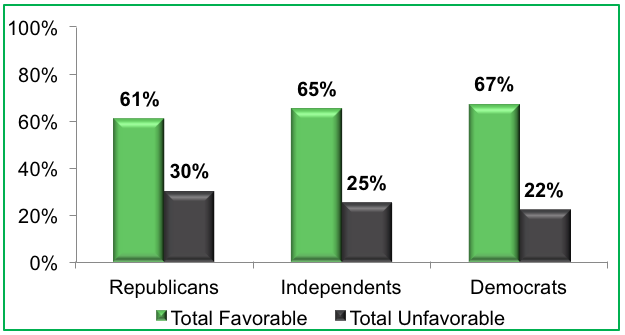Digital Learning Day is March 13, 2015!
According to CER’s 2014 America’s Attitudes Towards Education Reform, Americans are split on a blended learning environment, described as an environment where a portion of learning is done using digital technologies, and the rest through face-to-face instruction. In fact, 42% said they’d be more likely and 42% said they’d be less likely to send their children to a school that uses it.
Still, both terms, “blended learning” and “digital learning,” are viewed positively by over 60% of adults.
“Digital learning” receives high favorability from nearly all demographics, including 67% of Democrats, the highest favorability of all political parties. Majorities of Republicans and Independents are also favorable toward “digital learning,” with 61% and 65% voicing their favorable opinion respectively. Although Democrats are most favorable overall, Independents showed the most intensity toward “digital learning” as 38% are “very favorable,” 6% more than the average respondent. With the strength of this term among “blue” respondents, this may be a key term to use when messaging to Democrats and trying to bring them into the fold of educational reform.
Those stating that they receive their news from social media sources are 21% more likely than the average respondent (85%-64%) to be favorable toward “digital learning.” This may be because those receiving news from social media and online sources are very comfortable with this medium and can understand its application for education.
Those favorable toward charter schools are also more favorable toward “digital learning” as well, as 70% of those favoring charters also showed favorability toward “digital learning.”
Contrary to other terms tested, there was little difference between those who believe that schools can and cannot fire bad teachers. Both groups are favorable toward “digital learning” at 67% and 64%.
Blended Learning a Popular Approach. In general, men and women supported “blended learning” by 63% and 60% respectively, while dads and moms are favorable toward the term at 58% and 56% respectively.
Those without kids are also more favorable toward “blended learning” by 63% to 56%.
Similarly to that of “digital learning,” Democrats are also the most favorable political party toward “blended learning” as well. Republicans are favorable with 63% and Independents with 52%, but Democrats are favorable at 65%.
Contrary to what one might expect, those saying that their student’s current school works well for them are 13% more likely to have a favorable opinion of “blended learning” (64%-51%).
Those favoring and supporting charter schools are also favorable toward “blended learning” as 64% of those that support charter schools, and 65% of those that are favorable toward charter schools are also favorable toward “blended learning.”
Geography and Generations. Digital learning can be a powerful tool that can break geographical boundaries. When it comes to rural versus urban support for digital and blended learning, 34 percent of Americans living in urban areas have considered online schooling, and 21 percent of Americans in rural areas have considered online schooling.
There is no generational gap in support for blended learning, as 43% of those over the age of 55 say they’d be more likely to send their child to a school with blended learning, compared to 44% of those under the age of 35.
Learn more about Digital and Blended Learning in the U.S. Check out The Digital Learning Toolkit: The Facts About Digital and Blended Learning.


